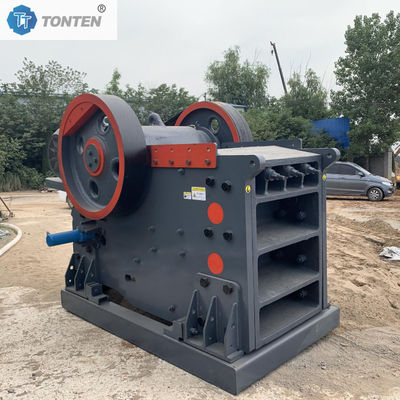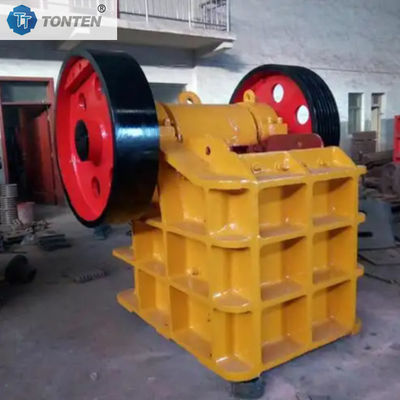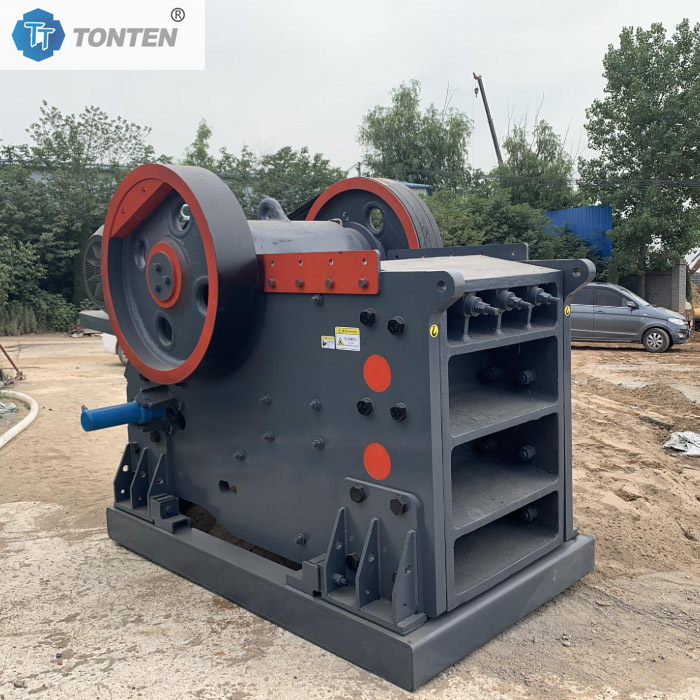Construction Mobile Portable Jaw Crusher Stone Crusher Jaw Crusher Machine
Product Details:
| Place of Origin: | China |
| Brand Name: | TONTEN |
| Model Number: | TT-PE600x900 |
Payment & Shipping Terms:
| Minimum Order Quantity: | 1 Set |
|---|---|
| Price: | Negotiable |
| Packaging Details: | standard export packing, container or as required |
| Delivery Time: | 5-7 working days |
| Payment Terms: | T/T |
| Supply Ability: | 30 sets/month |
|
Detail Information |
|||
| Max. Feeding Size: | 500mm | Discharge Opening Adjustment Range: | 65-160mm |
|---|---|---|---|
| Capacity/Production: | 60-200TPH | Dimension: | 3800×3200×3145mm (L×W×H) |
| Swing Jaw Stroke: | 35-40mm | Eccentricity: | 35-50mm |
| Toggle Plate Angle: | 18°-22° | Item: | Mobile Portable Jaw Crusher |
| Highlight: | portable jaw crusher machine,construction stone crusher,mobile jaw crusher with warranty |
||
Product Description
Construction Mobile Portable Jaw Crusher Stone Crusher Jaw Crusher Machine
Introduction:
Jaw crushers are widely used for primary crushing in industries such as mining, building materials, and road construction. Their operating principle is based on the periodic squeezing motion between the movable and fixed jaws, simulating the chewing action of an animal, breaking large materials into smaller particles. This equipment, characterized by its simple structure, reliable operation, strong adaptability, and easy maintenance, has become a core component in the crushing industry. Jaw crushers excel at handling high-hardness materials.
Jaw crusher machine application:
1. Mining and dressing: This is the most traditional and primary application area for jaw crushers. In mineral processing plants, they are the "first stage" of the crushing process.
1) Iron ore: Crushes large iron ore to provide the appropriate particle size for grinding and magnetic separation.
2) Non-ferrous metal ores such as copper, gold, lead, and zinc: Also used for primary crushing, crushing the raw ore to a size suitable for ball mills or subsequent crushers (such as cone crushers).
3) Bauxite: Crushes bauxite for subsequent alumina extraction.
4) Limestone: This is one of the largest applications. Crushed limestone is a core raw material for the production of cement, lime, and building aggregates.
5) Granite and basalt: In sand and gravel aggregate production lines, jaw crushers are the preferred coarse crushing equipment for these high-hardness rocks.
6) Quartz: Crushed quartz is used in the production of glass, ferrosilicon, and metallic silicon.
7) Phosphate rock: Crushed for use in the production of phosphate fertilizer.
8) Various industrial minerals, including barite and fluorite.
2. Building materials and aggregates: This is the most widely used market sector, serving the vast infrastructure construction sector.
1) Stone production lines: In large commercial concrete plants and quarries, jaw crushers serve as primary crushers, crushing blasted lumps to less than 250mm for entry into secondary crushing (such as impact crushers and cone crushers) and screening systems, ultimately producing crushed stone and manufactured sand of various specifications.
2) Cement production: Used to crush limestone, clay, shale, and other raw materials for cement production.
3. In the metallurgical industry, jaw crushers are used to crush coking coal, sintered ore, and other materials to prepare blast furnace charge. In foundries, they are used to crush pig iron and scrap castings.
4. Road construction and civil engineering: Mobile jaw crushers are often seen at construction sites for large-scale projects, such as highways, railways, airports, and dams. They can be driven directly to the site to crush excavated rock and slag on-site for direct use as roadbed material, significantly reducing material transportation costs.
5. Other Industrial Fields:
1) Ceramics and Glass Industry: Crushing raw materials such as quartz and feldspar.
2) Chemical Industry: Crushing certain chemical raw materials.
3) Research and Laboratory: Small jaw crushers are used for laboratory sample preparation, crushing samples to a specific particle size for analysis.
Jaw crusher machine specification:
|
Model |
Feed port size (mm) |
Maximum feed size (mm) |
Discharge port adjustment range (mm) |
Machine capacity (T/H) |
Speed |
Power (KW) |
Weight |
| PE-250X400 | 250X400 | 210 | 20-60 | 5-20 | 300r/min | 15 | 2.8T |
| PE-400X600 | 400X600 | 360 | 40-100 | 16-50 | 260r/min | 30 | 7.5T |
| PE-500X750 | 500X750 | 450 | 50-100 | 40-100 | 275r/min | 55-75 | 12T |
| PE-600X900 | 600X900 | 500 | 65-160 | 50-150 | 250r/min | 75 | 18T |
| PE-750X1060 | 750X1060 | 650 | 80-140 | 110-300 | 250r/min | 90-110 | 29T |
| PE-900X1200 |
900X1200 |
780 | 90-165 | 220-350 | 200r/min | 110-132 | 36T |
| PE-1200X1500 | 1200X1500 | 1100 | 150-300 | 400-500 | 180r/min | 160-180 | 52T |
| PEX-250X750 | 250X750 | 210 | 25-60 | 13-50 | 300r/min | 30 | 5.5T |
| PEX-250X1000 | 250X1000 | 210 | 25-80 | 20-80 | 330r/min | 42 | 7.1T |
![]()






